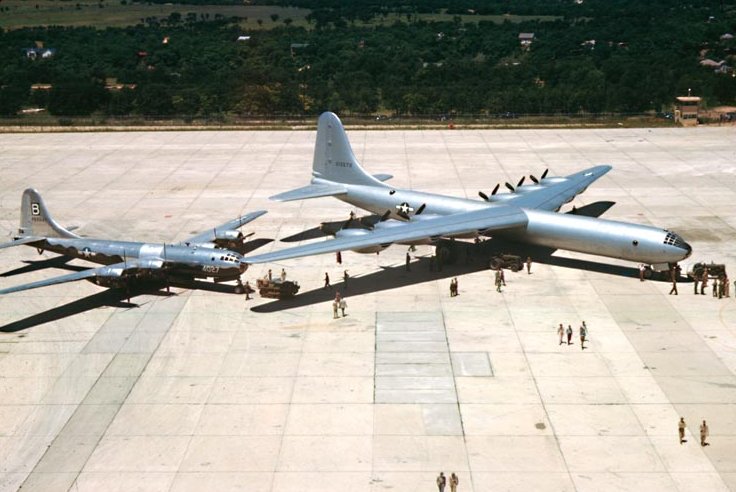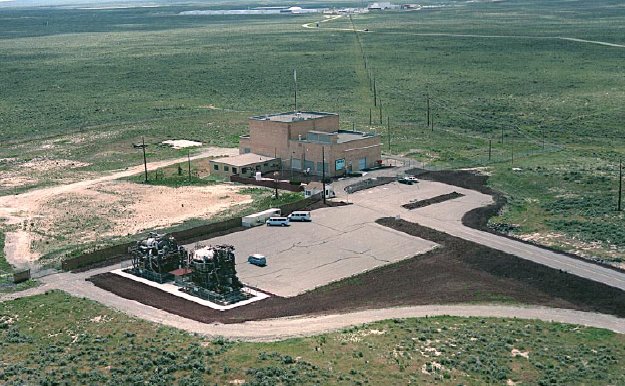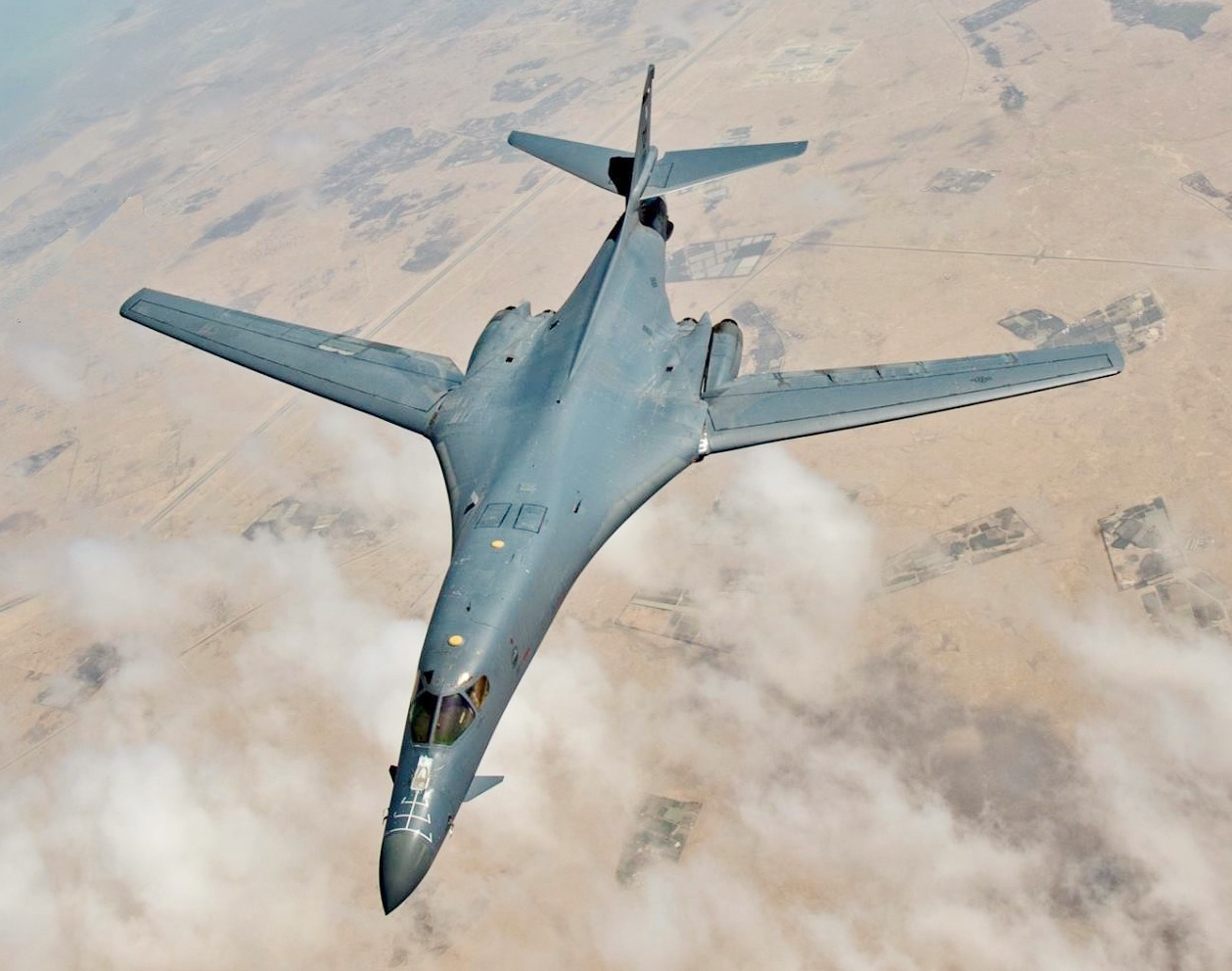|
B-36
The Convair B-36 "Peacemaker" is a strategic bomber that was built by Convair and operated by the United States Air Force (USAF) from 1949 to 1959. The B-36 is the largest mass-produced Reciprocating engine, piston-engined aircraft ever built. It had the longest wingspan of any combat aircraft ever built, at . The B-36 was the first bomber capable of delivering any of the nuclear weapons in the U.S. arsenal from inside its four bomb bays without aircraft modifications. With a range of and a maximum payload of , the B-36 was capable of intercontinental flight without refuelling. Entering service in 1948, the B-36 was the primary nuclear weapons delivery vehicle of Strategic Air Command (SAC) until it was replaced by the jet-powered Boeing B-52 Stratofortress beginning in 1955. All but four aircraft have been scrapped. Development The genesis of the B-36 can be traced to early 1941, prior to the entry of the United States into World War II. At the time, the threat existed that Bat ... [...More Info...] [...Related Items...] OR: [Wikipedia] [Google] [Baidu] |
Convair X-6
The Convair X-6 was a proposed experimental aircraft project to develop and evaluate a nuclear-powered jet aircraft. The project was to use a Convair B-36 bomber as a testbed aircraft, and though one NB-36H was modified during the early stages of the project, the program was canceled before the actual X-6 and its nuclear reactor engines were completed. The X-6 was part of a larger series of programs, costing US$7 billion in all, that ran from 1946 through 1961. Because such an aircraft's range would not have been limited by liquid jet fuel, it was theorized that nuclear-powered strategic bombers would be able to stay airborne for weeks at a time. Development and design In May 1946, the Nuclear Energy for the Propulsion of Aircraft (NEPA) project was started by the Air Force. Studies under this program were done until May 1951 when NEPA was replaced by the Aircraft Nuclear Propulsion (ANP) program. The ANP program included plans for Convair to modify two B-36s under the M ... [...More Info...] [...Related Items...] OR: [Wikipedia] [Google] [Baidu] |
Convair NB-36H
The Convair NB-36H was an experimental aircraft that carried a nuclear reactor. It was nicknamed "The Crusader". It was created for the Aircraft Nuclear Propulsion program, or the ANP, to show the feasibility of a nuclear-powered bomber. Its development ended with the cancellation of the ANP program. Design and development The Aircraft Nuclear Propulsion (ANP) program, and the preceding Nuclear Energy for the Propulsion of Aircraft (NEPA) project, worked to develop a nuclear propulsion system for aircraft. The United States Army Air Forces initiated Project NEPA on May 28, 1946. After funding of $10 million in 1947, NEPA operated until May 1951, when the project was transferred to the joint Atomic Energy Commission (AEC)/USAF ANP. The USAF pursued two different systems for nuclear-powered jet engines, the Direct Air Cycle concept, which was developed by General Electric, and Indirect Air Cycle, which was assigned to Pratt & Whitney. The program was intended to develop and tes ... [...More Info...] [...Related Items...] OR: [Wikipedia] [Google] [Baidu] |
Convair XC-99
The Convair XC-99, AF Ser. No. ''43-52436'', is a prototype heavy cargo aircraft built by Convair for the United States Air Force. It was the largest piston-engined land-based transport aircraft ever built, and was developed from the Convair B-36 Peacemaker bomber, sharing the wings and some other structures with it. The first flight was on 24 November 1947 in San Diego, California, and after testing it was delivered to the Air Force on 26 May 1949.Jacobsen & Wagner 1980, p. 41. The Convair Model 37 was a planned civil passenger variant based on the XC-99 but was not built. Design and development Design capacity of the XC-99 was of cargo or 400 fully equipped soldiers on its double cargo decks. A cargo lift was installed for easier loading. The engines face rearward in a pusher configuration. Planned civil passenger variant The Convair Model 37 was a large civil passenger design derived from the XC-99 but was never built. The Model 37 was to be of similar proportions to the ... [...More Info...] [...Related Items...] OR: [Wikipedia] [Google] [Baidu] |
Convair YB-60
The Convair YB-60 was an 1950s-era American prototype bomber aircraft for the United States Air Force. Design and development On 25 August 1950, Convair issued a formal proposal for a swept-winged version of the B-36 with all-jet propulsion. The Air Force was sufficiently interested that on 15 March 1951, it authorized Convair to convert two B-36Fs (49-2676 and 49-2684) as the B-36G. Since the aircraft was so radically different from the existing B-36, the designation was soon changed to YB-60. The YB-60 had 72% parts commonality with its piston-engined predecessor. The fuselages of the two aircraft were largely identical although the radar and bombing systems were located in a removable nose section as a result of the poor reliability of the B-36 installation. For initial flight testing a more streamlined nose with an instrumented boom was fitted; a wedge-shaped insert was added just outboard of the main landing gear to increase wing sweep and the tail surfaces were swept to m ... [...More Info...] [...Related Items...] OR: [Wikipedia] [Google] [Baidu] |
Convair
Convair, previously Consolidated Vultee, was an American aircraft manufacturing company that later expanded into rockets and spacecraft. The company was formed in 1943 by the merger of Consolidated Aircraft and Vultee Aircraft. In 1953, it was purchased by General Dynamics, and operated as their Convair Division for most of its corporate history. Convair is best known for its military aircraft; it produced aircraft such as the Convair B-36 Peacemaker and Convair B-58 Hustler strategic bombers, and the Convair F-102 Delta Dagger and Convair F-106 Delta Dart interceptors. It also manufactured the first Atlas rockets, including the rockets that were used for the crewed orbital flights of Project Mercury. The company's subsequent Atlas-Centaur design continued this success and derivatives of the design remain in use as of 2020. The company also entered the jet airliner business with its Convair 880 and Convair 990 designs. These were smaller than contemporary aircraft like ... [...More Info...] [...Related Items...] OR: [Wikipedia] [Google] [Baidu] |
Strategic Air Command
Strategic Air Command (SAC) was both a United States Department of Defense Specified Command and a United States Air Force (USAF) Major Command responsible for command and control of the strategic bomber and intercontinental ballistic missile components of the United States military's strategic nuclear forces from 1946 to 1992. SAC was also responsible for the operation of strategic reconnaissance aircraft and airborne command post aircraft as well as most of the USAF's aerial refueling fleet, including aircraft from the Air Force Reserve (AFRES) and Air National Guard (ANG). SAC primarily consisted of the Second Air Force (2AF), Eighth Air Force (8AF) and the Fifteenth Air Force (15AF), while SAC headquarters (HQ SAC) included Directorates for Operations & Plans, Intelligence, Command & Control, Maintenance, Training, Communications, and Personnel. At a lower echelon, SAC headquarters divisions included Aircraft Engineering, Missile Concept, and Strategic Communicati ... [...More Info...] [...Related Items...] OR: [Wikipedia] [Google] [Baidu] |
Boeing B-52 Stratofortress
The Boeing B-52 Stratofortress is an American long-range, subsonic, jet-powered strategic bomber. The B-52 was designed and built by Boeing, which has continued to provide support and upgrades. It has been operated by the United States Air Force (USAF) since the 1950s. The bomber is capable of carrying up to 70,000 pounds (32,000 kg) of weapons,"Fact Sheet: B-52 Superfortress." ''Minot Air Force Base'', United States Air Force, October 2005. Retrieved: 12 January 2009. and has a typical combat range of around 8,800 miles (14,080 km) without aerial refueling. Beginning with the successful contract bid in June 1946, the B-52 design evolved from a < ... [...More Info...] [...Related Items...] OR: [Wikipedia] [Google] [Baidu] |
Amerikabomber
The ''Amerikabomber'' () project was an initiative of the German Ministry of Aviation (''Reichsluftfahrtministerium'') to obtain a long-range strategic bomber for the ''Luftwaffe'' that would be capable of striking the United States (specifically New York City) from Germany, a round-trip distance of about . The concept was raised as early as 1938, but advanced plans for such a long-range strategic bomber design did not begin to appear before ''Reichsmarschall'' Hermann Göring until early 1942. Various proposals were put forward, but these plans were all eventually abandoned as they were too expensive, too reliant on rapidly-diminishing materiel and production capacity, and/or technically unfeasible. Background According to Albert Speer's book, '' Spandau: The Secret Diaries'', Adolf Hitler was fascinated with the idea of New York City in flames. In 1937, Willy Messerschmitt hoped to win a lucrative contract by showing Hitler a prototype of the Messerschmitt Me 264 that was be ... [...More Info...] [...Related Items...] OR: [Wikipedia] [Google] [Baidu] |
1943 In Aviation
This is a list of aviation-related events from 1943: Events * Watanabe Iron Works transfers its aircraft manufacturing business to a new subsidiary, the Kyushu Airplane Company Ltd. January * January 5 – In support of the American occupation of Amchitka in the Aleutian Islands scheduled for the next day, United States Army Air Forces aircraft fly photographic reconnaissance missions over Amchitka and strike Japanese forces on Attu and Kiska, sinking two fully loaded Japanese transports approaching Attu and Kiska. * January 6 – Firing at a Japanese Aichi D3A dive bomber ( Allied reporting name "Val") south of Guadalcanal, the United States Navy light cruiser claims the first hit on an enemy aircraft by antiaircraft ammunition employing the Mark 32 VT proximity fuse. * January 13 ** The U.S. Army Air Forces activate the Thirteenth Air Force in New Caledonia. ** Operating from Guadalcanal, United States Marine Corps Major Joe Foss shoots down three Japanese Mitsubishi ... [...More Info...] [...Related Items...] OR: [Wikipedia] [Google] [Baidu] |
Nuclear Weapon
A nuclear weapon is an explosive device that derives its destructive force from nuclear reactions, either fission (fission bomb) or a combination of fission and fusion reactions ( thermonuclear bomb), producing a nuclear explosion. Both bomb types release large quantities of energy from relatively small amounts of matter. The first test of a fission ("atomic") bomb released an amount of energy approximately equal to . The first thermonuclear ("hydrogen") bomb test released energy approximately equal to . Nuclear bombs have had yields between 10 tons TNT (the W54) and 50 megatons for the Tsar Bomba (see TNT equivalent). A thermonuclear weapon weighing as little as can release energy equal to more than . A nuclear device no larger than a conventional bomb can devastate an entire city by blast, fire, and radiation. Since they are weapons of mass destruction, the proliferation of nuclear weapons is a focus of international relations policy. Nuclear weapons have been d ... [...More Info...] [...Related Items...] OR: [Wikipedia] [Google] [Baidu] |
United States Army Air Corps
The United States Army Air Corps (USAAC) was the aerial warfare service component of the United States Army between 1926 and 1941. After World War I, as early aviation became an increasingly important part of modern warfare, a philosophical rift developed between more traditional ground-based army personnel and those who felt that aircraft were being underutilized and that air operations were being stifled for political reasons unrelated to their effectiveness. The USAAC was renamed from the earlier United States Army Air Service on 2 July 1926, and was part of the larger United States Army. The Air Corps became the United States Army Air Forces (USAAF) on 20 June 1941, giving it greater autonomy from the Army's middle-level command structure. During World War II, although not an administrative echelon, the Air Corps (AC) remained as one of the combat arms of the Army until 1947, when it was legally abolished by legislation establishing the Department of the Air Force. The A ... [...More Info...] [...Related Items...] OR: [Wikipedia] [Google] [Baidu] |
Strategic Bomber
A strategic bomber is a medium- to long-range Penetrator (aircraft), penetration bomber aircraft designed to drop large amounts of air-to-ground weaponry onto a distant target for the purposes of debilitating the enemy's capacity to wage war. Unlike tactical bombing, tactical bombers, Penetrator (aircraft), penetrators, fighter-bombers, and attack aircraft, which are used in air interdiction operations to attack enemy combatants and military equipment, strategic bombers are designed to fly into enemy territory to destroy strategic targets (e.g., infrastructure, logistics, Military base, military installations, factories, etc.). In addition to strategic bombing, strategic bombers can be used for tactical bombing, tactical missions. There are currently only three countries that operate strategic bombers: the United States, Russia and China. The modern strategic bomber role appeared after Strategic bombing during World War II, strategic bombing was widely employed, and Atomic bombing ... [...More Info...] [...Related Items...] OR: [Wikipedia] [Google] [Baidu] |









